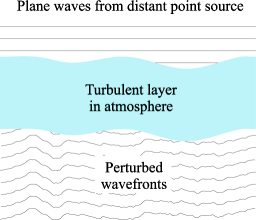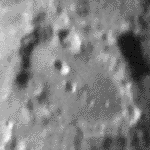Seeing Monitor
Translation: Polish
Introduction
Matjiesfonteinin the Karoo has been identified as one of three suitable sites for the new Space Geodesy Outstation. A Lunar Laser Ranging (LLR) system is to form part of the geodetic instrumentation to be located on-site. Laser ranging to the Moon requires astronomical seeing conditions which allow for propagation of a laser beam through the atmosphere without excessive degradation caused by turbulence. Optimally we require the astronomical seeing conditions to be ~ 1 arcsecond, or better. To evaluate the site for suitable conditions for the various experiments, we need to measure seeing conditions, amongst others. To characterise seeing conditions at Matjiesfontein, we would like to develop and implement an automated seeing monitor system on-site.
|
Atmospheric turbulence Atmospheric turbulence results in perturbations of the electromagnetic wave fronts emanating from extra-planetary sources. These perturbations cause starlight to undergo refraction, absorption, dispersion, blurring etc. Atmospheric turbulence thus causes stellar images to spread out and jump around when viewed through a telescope. From this change in image relative to that expected under perfect conditions, we can derive a measure of the seeing quality. |
 Schematic diagram illustrating how optical wavefronts from a distant star may be perturbed by a turbulent layer in the atmosphere. The vertical scale of the wavefronts plotted is highly exaggerated. Taken from Bob Tubbs' thesis (http://www.mrao.cam.ac.uk/telescopes/coast/theses/rnt/node4.html) |
Automated seeing monitor system
The proposed system is to consist of a telescope, CCD camera and control/processing PC. The procedure involves observing of stars at various hour angles and declinations on the night sky and capturing frames of varying exposure times throughout the night. Close binaries will also have to be observed for calibration and verification purposes. Statistical analysis of the captured images will be compared with the theoretical Airy function, which is a measure of an absence of turbulence. Deviations from the Airy function will then give an indication of seeing conditions.
Hardware and software
An initial test setup will be deployed at HartRAO. Data will be collected and processed to test the setup and procedures. The development of the hardware and interfaces will commence hereafter. Data processing and analysis will be streamlined and automated. Thereafter, Sutherland will serve as control site, allowing for comparison of our results with that of SALT’s MASS-DIMM (Multi Aperture Scintillation Sensor - Differential Image Motion Monitor).
 |
 |


